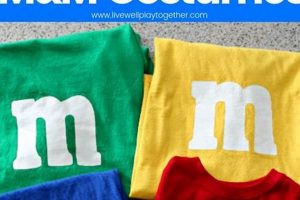Handcrafted attire for babies, typically created by parents or caregivers, allows for unique and personalized garments for special occasions or imaginative play. Examples include a felt-covered box transformed into a robot outfit or repurposed fabric sewn into animal-themed apparel. These items are generally designed with safety and comfort as paramount considerations for the infant wearer.
The creation of personalized apparel for the youngest members of a family fosters creativity and resourcefulness. This activity provides a cost-effective alternative to commercially produced options, often utilizing materials already available. Historically, crafting garments at home was commonplace; modern adaptations reflect a resurgence in handmade goods and a desire for individuality, further ensuring items are free of potentially harmful chemicals found in mass-produced clothing.
The subsequent sections will explore various themes and approaches to constructing individualized baby clothing, offering detailed instructions and practical advice for achieving successful and satisfying results. These guidelines focus on safety, comfort, and aesthetic appeal, providing a starting point for creating memorable and cherished items.
Guidelines for Handcrafting Baby Attire
The following outlines essential considerations for creating safe, comfortable, and visually appealing attire for infants. Adherence to these points maximizes the likelihood of a positive outcome.
Tip 1: Prioritize Non-Toxic Materials: Select fabrics and embellishments certified free from harmful chemicals such as phthalates and lead. Opt for natural fibers like organic cotton, which minimize the risk of skin irritation.
Tip 2: Ensure Secure Fastenings: Implement robust closures, such as snaps or Velcro, positioned to prevent accidental ingestion. Avoid buttons or small decorations that could detach and pose a choking hazard.
Tip 3: Maintain Unrestricted Movement: Design apparel that allows for full range of motion in the limbs and torso. Overly constrictive garments can impede development and cause discomfort.
Tip 4: Simplify Cleaning Procedures: Choose fabrics that are machine washable and dryer-safe. Practicality is paramount, given the frequency with which infant attire requires cleaning.
Tip 5: Emphasize Soft Seams: Construct garments with flat or enclosed seams to prevent chafing and skin irritation. Consider using a serger or overlock machine to create smooth, durable edges.
Tip 6: Regularly Inspect for Wear and Tear: Routinely examine handcrafted items for loose threads, damaged closures, or other potential hazards. Repair or replace as needed to maintain safety.
Tip 7: Consider Seasonal Appropriateness: Design attire that is suitable for the prevailing climate. Lightweight, breathable fabrics are ideal for warm weather, while insulated materials are appropriate for colder conditions.
The above suggestions emphasize the importance of safety, comfort, and practicality in the creation of baby attire. Integrating these considerations during the crafting process yields items that are both aesthetically pleasing and functionally sound.
The subsequent section will provide resources for patterns and inspiration, empowering readers to embark on their own baby attire projects.
1. Safety
The paramount concern when handcrafting infant attire centers on safety. Garments intended for babies must adhere to stringent guidelines to mitigate potential hazards inherent in clothing construction and material selection.
- Non-Toxic Materials
Fabric selection is critical. Materials utilized should be certified free of harmful substances such as lead, phthalates, and flame retardants. Natural fibers like organic cotton are preferred due to their reduced potential for allergic reactions and skin irritation. Dyes must also be non-toxic and colorfast to prevent leaching during washing or contact with saliva.
- Secure Fastenings
Closures present a significant safety risk. Buttons, snaps, and zippers must be securely attached to prevent detachment and potential ingestion. Avoid small, decorative embellishments that could easily become dislodged. Velcro closures should be of sufficient strength to prevent accidental opening and should have rounded edges to minimize the risk of scratching. Seams must be reinforced to prevent unraveling, which could create loose threads that pose a choking hazard.
- Appropriate Fit
Garment fit impacts safety. Overly restrictive clothing can impede breathing and circulation. Excessively loose clothing presents a risk of entanglement and suffocation. Armholes and necklines must be appropriately sized to prevent constriction. Avoid long, trailing elements that could become caught on objects or create a tripping hazard. Garments should allow for unrestricted movement of the limbs and torso.
- Flame Retardancy
While naturally flame-resistant materials are preferred, ensure any synthetic fabrics used meet relevant safety standards for flame retardancy. Avoid applying aftermarket flame retardant treatments, as these can contain harmful chemicals. Consider the intended use of the garment when assessing flame retardancy needs. For example, sleepwear may require stricter flame retardant properties than daytime attire.
Adherence to these safety facets minimizes the risks associated with handcrafted baby attire. Meticulous material selection, secure construction techniques, and careful attention to fit ensure that garments are both aesthetically pleasing and safe for infant wear. Deviation from these guidelines can compromise infant wellbeing, emphasizing the critical role of safety considerations in the crafting process.
2. Comfort
Comfort is a critical determinant of the suitability of infant attire, influencing an infant’s mood, sleep patterns, and overall well-being. Handcrafted apparel for babies, unlike mass-produced items, offers the potential for tailoring garments precisely to an infants needs, addressing specific sensitivities or preferences. The absence of harsh chemicals, rigid seams, or ill-fitting designs inherent in some commercially available options can be directly mitigated through the selection of appropriate materials and construction techniques. For instance, a garment crafted from ultra-soft, breathable organic cotton and devoid of rough embellishments can demonstrably reduce skin irritation and discomfort, leading to improved sleep quality and reduced fussiness.
The practical application of comfort considerations extends beyond mere material selection. Careful attention to garment construction, including flat or enclosed seams, tagless designs, and a fit that allows for unrestricted movement, contributes significantly to the overall comfort level. Elastic waistbands, if uti
lized, must be gentle and non-binding. Furthermore, consideration of the garment’s intended use and the prevailing climate is essential. A lightweight, breathable linen outfit is ideal for warm weather, while a soft, fleece-lined garment provides warmth and comfort during colder periods. Ill-considered choices, such as scratchy wool blends or overly tight elastic, can result in discomfort, skin irritation, and behavioral distress in infants.
In conclusion, comfort is not merely a desirable attribute but a fundamental requirement for infant clothing. The ability to customize and control the materials and construction of handcrafted baby garments allows for the creation of attire that prioritizes an infant’s well-being. The challenge lies in the careful selection of materials, precise execution of construction techniques, and ongoing assessment of the garment’s impact on the infant’s comfort level. Understanding and addressing these considerations enhances the value and practicality of handcrafting infant attire, promoting both the baby’s comfort and the caregiver’s peace of mind.
3. Originality
Originality, in the context of handcrafting baby attire, represents a departure from mass-produced uniformity. It allows for individualized expression and customization, resulting in garments that reflect unique aesthetics and personalized functionality.
- Personalized Embellishments
Originality manifests through the incorporation of personalized embellishments. Embroidered monograms, hand-painted designs, or appliqued motifs transform generic clothing into distinct and meaningful pieces. For example, a plain cotton onesie adorned with the child’s name and birthdate in hand-stitched embroidery becomes a singular item, imbued with sentimental value.
- Unique Material Combinations
Combining unconventional materials offers another avenue for originality. Juxtaposing textures, patterns, and fabric types creates visually striking and tactilely interesting garments. A denim jacket lined with vintage floral fabric exemplifies this approach, blending rugged practicality with delicate femininity.
- Customized Design Adaptations
Modifying existing patterns or creating entirely new designs from scratch facilitates the expression of originality. Altering the silhouette of a standard romper or drafting a pattern for a specialized garment, such as a sensory-friendly onesie with concealed seams, demonstrates a commitment to individualized design.
- Thematic Conceptualization
Employing thematic conceptualization allows for the creation of cohesive and imaginative wardrobes. Designing a series of garments based on a shared theme, such as nautical motifs or animal representations, results in a coordinated collection that reflects a unified artistic vision. A selection of onesies featuring hand-painted sea creatures or appliqued sailboats illustrates this approach.
The pursuit of originality in crafting baby attire extends beyond mere aesthetics. It fosters creativity, resourcefulness, and a deeper connection between the maker and the recipient. The resulting garments, imbued with personal meaning and unique design elements, serve as tangible expressions of individuality and artistic expression.
4. Durability
Durability, a key factor in the creation of homemade baby attire, directly influences the garment’s lifespan and the overall return on investment in time and materials. Substandard durability translates into a reduced usability period, negating the cost-effectiveness commonly associated with handcrafted items. For instance, a poorly constructed outfit, using flimsy fabric and weak seams, may only withstand a few wash cycles before requiring repair or outright disposal, rendering it a less sustainable choice compared to commercially available, well-made alternatives. Conversely, attention to durability through robust construction techniques and quality material selection significantly extends the garment’s usable life, providing greater value and reducing textile waste.
The practical application of durability considerations extends to every stage of the creation process. Selecting fabrics known for their resilience, such as tightly woven cotton blends or durable knits, forms the foundation of long-lasting garments. Reinforcing stress points, such as seams, closures, and areas prone to abrasion, through techniques like double stitching or using interfacing, further enhances structural integrity. Employing quality notions, such as sturdy zippers and secure snaps, minimizes the likelihood of component failure. For example, using metal snaps rather than plastic ones on a diaper cover significantly increases its resistance to wear and tear, prolonging its service life. Furthermore, proper care instructions, clearly communicated to the user, are essential for maintaining the garment’s integrity through repeated washing and wear.
In summary, durability is not merely an ancillary consideration but an integral attribute of high-quality, handcrafted baby attire. Prioritizing durable materials, robust construction techniques, and clear care instructions ensures that these garments withstand the rigors of infant wear, offering lasting value and contributing to sustainable practices. Overlooking this critical aspect undermines the very purpose of creating homemade clothing, potentially resulting in garments that are aesthetically pleasing but functionally deficient.
5. Affordability
The creation of baby attire through do-it-yourself methods often stems from a desire to mitigate expenses associated with commercially produced goods. Infant clothing, especially specialty items like , can represent a significant financial burden for families. Handcrafting provides a mechanism for controlling costs by leveraging existing resources and minimizing reliance on retail markets. The primary driver is often the difference in price between purchasing raw materials versus finished products.
The actual cost savings vary depending on multiple factors. These include the availability of pre-owned fabric, the complexity of the design, and the skill level of the individual undertaking the project. For example, repurposing fabric remnants from other sewing projects significantly reduces material costs compared to purchasing new textiles. Similarly, a simple pattern for a basic onesie requires less time and fewer resources than a complex design with intricate embellishments. The ability to acquire materials at discounted prices, such as end-of-bolt fabric sales or thrift store finds, also directly impacts the overall affordability of the project. This direct control over material selection allows for informed decisions balancing cost with quality and durability.
The economic advantage of producing baby apparel at home is frequently realized, but requires careful planning and execution. The most compelling connection between cost-effectiveness and handcrafted goods lies in the ability to utilize pre-owned materials and adapt designs to minimize resource consumption. This practice translates to a lower expenditure and increased access to customized apparel for infants. The long-term financial benefits are contingent upon factors such
as the longevity of the handmade items and the ongoing availability of affordable materials. The financial implications necessitates a thorough assessment of the required skillset and available resources before undertaking such a endeavor.
6. Simplicity
Simplicity, when applied to handcrafted baby attire, represents an approach that prioritizes ease of construction, readily available materials, and uncomplicated designs. This focus reduces the barrier to entry for individuals with limited sewing experience, enabling wider participation in creating customized clothing for infants.
- Basic Pattern Selection
Prioritizing simple patterns, such as those for basic onesies, blankets, or hats, significantly reduces the complexity of the project. These patterns typically involve minimal seams, straightforward construction techniques, and limited embellishments. For example, a pattern requiring only straight stitching and basic finishing techniques is considerably more accessible than one involving intricate shaping or complex closures. The selection of rudimentary patterns also diminishes the likelihood of errors and reduces the time commitment required for completion.
- Limited Material Palette
Restricting the number of materials used streamlines the crafting process. Focusing on a single type of fabric or a limited color palette simplifies material sourcing and reduces the potential for mismatched components. For instance, using only organic cotton knit in neutral tones eliminates the need to coordinate multiple fabrics with varying textures and weights. A simplified material palette also contributes to a cohesive and aesthetically pleasing final product, even with basic construction methods.
- Minimal Embellishments
Reducing or eliminating embellishments, such as ruffles, lace, or intricate embroidery, significantly simplifies the crafting process. Embellishments often require specialized tools, advanced sewing skills, and considerable time investment. Opting for plain, unadorned designs allows for a focus on basic construction techniques and ensures a clean, minimalist aesthetic. The absence of embellishments also reduces the risk of choking hazards and minimizes potential sources of skin irritation for the infant.
- Straightforward Construction Techniques
Employing only basic sewing techniques, such as straight stitching, zigzag stitching, and simple seam finishes, facilitates ease of construction. Avoiding complex techniques like darts, pleats, or bias binding streamlines the process and reduces the potential for errors. Using a sewing machine with basic functionality or even hand-sewing techniques for simpler projects allows for wider accessibility. The emphasis on straightforward techniques ensures that the project remains manageable and achievable for individuals with limited sewing experience.
The pursuit of simplicity in creates accessible avenues for personalized expression while mitigating the demanding aspects that could inhibit engagement. This design ethos ensures the accessibility, feasibility, and enjoyment of crafting individualized items for infants, irrespective of individual capability.
Frequently Asked Questions
The following addresses common inquiries regarding the creation of clothing for infants, providing detailed explanations and practical considerations.
Question 1: What constitutes a safe material for infant clothing?
Materials designated for use in baby garments require certification as free from harmful chemicals, including but not limited to phthalates, lead, and formaldehyde. Natural fibers, such as organic cotton and bamboo, minimize potential skin irritation. Dyes should be non-toxic and colorfast to prevent leaching.
Question 2: How can choking hazards be minimized when crafting baby attire?
Small components, including buttons, beads, and ribbons, present a significant risk. Closures must be securely affixed to prevent detachment. Embroidered or appliqued embellishments should be executed with reinforced stitching to prevent unraveling and the creation of loose threads.
Question 3: What fit considerations are paramount for infant garments?
Clothing should permit unrestricted movement. Overly constrictive garments impede breathing and circulation. Excessively loose clothing poses entanglement risks. Necklines and armholes require sizing appropriate for preventing constriction. Elastic waistbands must possess sufficient elasticity to avoid binding.
Question 4: How should fabric be prepped before construction?
All fabric should undergo pre-washing and drying to pre-shrink the material. Failure to do so results in dimensional changes after garment construction, affecting fit and appearance. Pre-washing also removes any residual chemicals from the manufacturing process.
Question 5: What seam finishes are recommended for infant clothing?
Flat or enclosed seams minimize chafing. Overlock or serged edges prevent fraying and contribute to durability. Seam allowances require trimming to reduce bulk. The selection of appropriate seam finishes enhances both comfort and the longevity of the finished product.
Question 6: How can the durability of hand-crafted baby garments be improved?
Reinforce stress points with multiple rows of stitching. Utilize high-quality threads. Select durable fabrics suited for frequent washing and wear. Employ interfacing or stabilizers in areas requiring added support. Proper care during laundering extends the lifespan of the finished garments.
Prioritizing safety, comfort, and durability ensures that homemade items are both aesthetically pleasing and functionally appropriate for infant wear. Adherence to these guidelines maximizes the likelihood of a positive and enduring outcome.
The next area of focus is sources of inspiration and pattern acquisition for your project.
DIY Infant Costumes
The preceding discussion has explored the multifaceted nature of , emphasizing safety, comfort, originality, durability, affordability, and simplicity. These elements, when carefully considered and integrated into the crafting process, result in garments that are both aesthetically pleasing and functionally appropriate for infant wear. Prioritizing non-toxic materials, secure construction techniques, and designs that accommodate unrestricted movement are paramount.
The sustained practice of creating personalized apparel for infants fosters resourcefulness, creativity, and a heightened awareness of material selection and production processes. The creation of uniquely styled clothes is an effort of love for the babies and it’s highly recommended to implement it. Further exploration of innovative designs and sustainable material sourcing holds the potential to elevate the art of crafting, enriching the lives of both the creator and the child.







